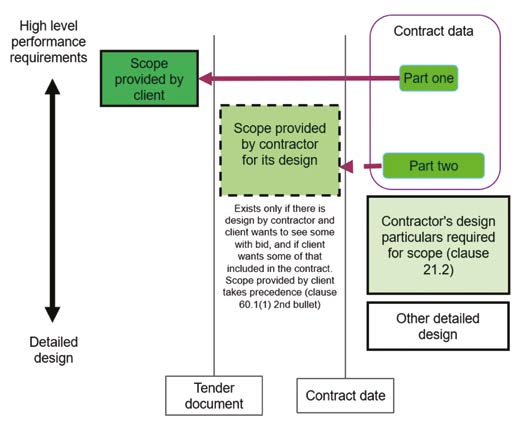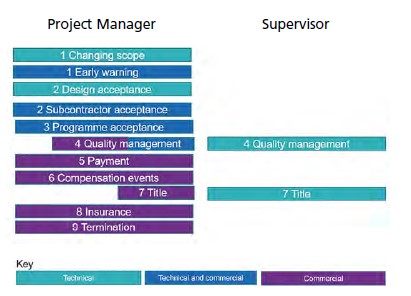
Key Points
- Most NEC4 ECC contracts now give contractors a significant proportion of the design, with the original designers limited to preliminary design and scope drafting.
- There is a risk that an NEC4 ECC project manager does not have sufficient design knowledge to accept the contractor’s design and change the scope appropriately.
- Clients should consider engaging the original designer as the supervisor and, as a minimum, as support to the project manager to ensure design continuity and quality
It has been suggested that clients may have lost the role and skill of their designers in supervising construction contracts under the NEC4 Engineering and Construction Contract (ECC) (Dulake, 2022). This article gives guidance to NEC clients on why and how to keep their designers involved.
Design responsibilities
Many NEC4 ECC contracts now give the contractor responsibility for a significant proportion of the design. In the early stages of a project, a client normally engages its own designer to carry out some preliminary design and assist with drafting the scope and other tender documents for the design and build construction contract.
How far a client takes the design for each part of the works is their decision. There is a concern that some projects are being procured for construction with insufficient design maturity and solutions are being proposed that are not underpinned by sufficiently engineered or designed detail. Many think clients should sometimes be taking that design further prior to awarding contracts for the detailed design and build.
In the case of option X22 early contractor involvement (ECI), the client must decide how much design is done prior to appointing the contractor for stage one, and how much design is carried out in stage one (often by the contractor) prior to setting the price for stage two implementation. In NEC4 ECC, including that in stage two of an ECI arrangement, the design is in one of three places.
- The design done on behalf of the client prior to issue of tender documents (or the agreement of stage two in ECI) is included in the scope.
- The client may ask for bidders to submit some design at tender stage and include that in the ‘Scope provided by the Contractor for its design’. If the bidder’s design later must be changed to meet the client’s scope, the contract is clear (clause 60.1(1)) this will not be a compensation event. Hence that risk is taken by the contractor. The same document can be used in stage two of ECI and will include design carried out by the contractor in stage one.
- In the scope the client will also set out the particulars of the contractor’s design to be submitted to the project manager for acceptance after contract award (clause 21.2)(see Figure 1).
Different job titles
The project manager and supervisor roles may be carried out by the client’s own staff or by consultants employed by the client. On small contracts the same person may be appointed to both roles, while on major contracts the project manager and supervisor will be separate and may need support staff and nominated delegates (clause 14.2). Clearly specific skills are needed for the roles.
Project manager role
As shown in Figure 2, the project manager’s role is both commercial and technical. The project manager is required to assess payment and agree and manage the compensation event process, which means accepting quotations for time and money and sometimes making their own assessment. The role of accepting subcontractors also needs a mix of technical and commercial skills, as does acceptance of the contractor’s programme, for which the assistance of a specialist construction planner is often needed. Furthermore, notifying early warnings need an understanding of the technical issues in the scope and the possible commercial effects of a matter.
The most overtly design-related actions of the project manager are changing the scope (clause 14.3), accepting contractor’s proposals to change the scope (clause 16.1) and accepting the contractor’s design (clause 21.2). The original scope was most likely drafted by the client’s designer in the early stages of the project. The project manager has unlimited power to change that scope but there is a risk they may not fully understand the technical implications of doing so. It is essential for the project manager, particularly on today’s large infrastructure projects, to be fully aware of the impacts that a change in scope, based on a construction decision, will have on the design process. The programming implications and time impact across the project of changes in scope are often under-estimated due to the interconnectivity of design activities on the critical path.
If the project manager is not the designer, it is recommended that the client retains its designer to advise the project manager on changes to the scope, whether initiated by the project manager (clause 14.3) or proposed by the contractor (clause 16.1). It seems sensible to require the project manager to get the designer to agree or at least advise on all proposed changes to the scope.
Many scope changes are unfortunately required to correct ambiguities in the sometimes significant number of documents that make up the scope. Each such change will be a compensation event (clause 60.1(1)) and the change will be assessed in favour of the contractor (clause 63.10). Under UK contract law, the project manager, with a formal role to manage the contract, is required to act impartially although employed by the client, so they should make such corrections to the scope when required. The designer should also recognise that the change is required but, if they prepared the scope, may be less keen to do so. This possible tension should be recognised and managed by the project manager.
The project manager has a period of reply to accept the contractor’s submitted ‘particulars of its design’ or state reasons for not accepting them. This is clearly a very technical role. The best organisation to carry out that role is likely to be the original designer, which really understands the scope. It is recommended that the client engages its original designer to support the project manager in the acceptance of the contractor’s designs.
Supervisor role
The supervisor’s main role is to monitor the contractor’s compliance with what it has signed up to deliver in the scope and compliance with its own designs. The role is entirely technical. The supervisor may be required by the scope to carry out specific testing and inspections. They will receive results of any tests carried out by the contractor and will notify any defects that occur. The quality management role is like the clerk of works in JCT contracts and part of the role of the resident engineer under ICC and Fidic contracts, but supervisors have many more direct obligations to act in accordance with the contract. Their key responsibilities are to instruct the contractor to search for defects (clause 43.1) and to notify defects (clause 43.2).
It is suggested that client’s original designer, which understands the design, the design intent and probably contributed to the scope, is likely the best organisation to provide the person to carry out the role of supervisor with any required delegates. The clear benefit of using the original designer to fulfil the supervisor role is maintaining the continuity of design knowledge in construction supervision. All non-compliant materials, errors, omissions and changes in construction require designer input.
It should be noted that the supervisor never accepts anything in the ECC. Rather they notify ‘Defects’, which are anything not complying with the scope or the contractor’s accepted designs. There is no formal clause for the supervisor to confirm that the contractor has properly corrected a defect or to manage a list of defects. However, the supervisor will need to do both.
The supervisor’s last act is to issue a defects certificate, which is simply a list of the defects that have been notified by them and not corrected or a statement there are none. This is effectively the supervisor’s sign-off that, apart from the defects on the defects certificate, the works have been constructed as per the scope and the contractor’s design. There is clearly a role here for the original designer.
Summary
NEC4 ECC dispenses with the role of the ‘engineer’, traditionally the client’s designer, and replaces it with the project manager and supervisor. But NEC clients should understand they will be well served by retaining their original designer as supervisor and at least as support to the project manager. The benefit of this approach will be to increase the chances of NEC-procured projects being delivered successfully.
Reference
Dulake C (2022) Good design and engineering is critical to creating and delivering successful projects. New Civil Engineer, 4 January 2022, www.newcivilengineer.com/latest/good-designand-engineering-is-critical-to-creating-anddelivering-successful-projects-04-01-2022

Figure 1. Documents including design in an NEC4 ECC

Figure 2. Roles of project manager and supervisor in each part of NEC4 ECC




